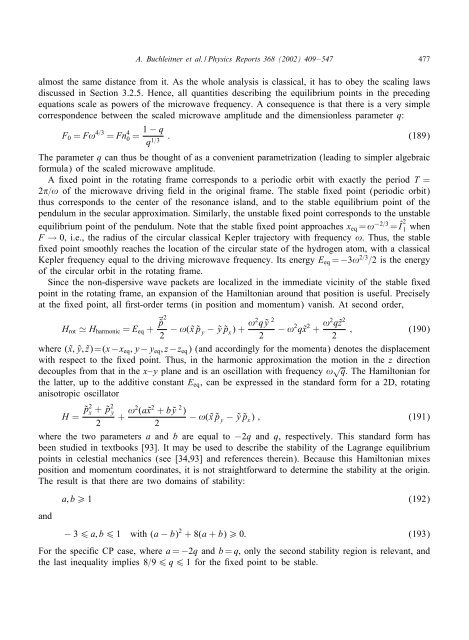Non-dispersive wave packets in periodically driven quantum systems
Non-dispersive wave packets in periodically driven quantum systems
Non-dispersive wave packets in periodically driven quantum systems
Create successful ePaper yourself
Turn your PDF publications into a flip-book with our unique Google optimized e-Paper software.
A. Buchleitner et al. / Physics Reports 368 (2002) 409–547 477<br />
almost the same distance from it. As the whole analysis is classical, it has to obey the scal<strong>in</strong>g laws<br />
discussed <strong>in</strong> Section 3.2.5. Hence, all quantities describ<strong>in</strong>g the equilibrium po<strong>in</strong>ts <strong>in</strong> the preced<strong>in</strong>g<br />
equations scale as powers of the micro<strong>wave</strong> frequency. A consequence is that there is a very simple<br />
correspondence between the scaled micro<strong>wave</strong> amplitude and the dimensionless parameter q:<br />
F0 = F! 4=3 = Fn 4 0 =<br />
1 − q<br />
q 1=3 : (189)<br />
The parameter q can thus be thought of as a convenient parametrization (lead<strong>in</strong>g to simpler algebraic<br />
formula) of the scaled micro<strong>wave</strong> amplitude.<br />
A xed po<strong>in</strong>t <strong>in</strong> the rotat<strong>in</strong>g frame corresponds to a periodic orbit with exactly the period T =<br />
2 =! of the micro<strong>wave</strong> driv<strong>in</strong>g eld <strong>in</strong> the orig<strong>in</strong>al frame. The stable xed po<strong>in</strong>t (periodic orbit)<br />
thus corresponds to the center of the resonance island, and to the stable equilibrium po<strong>in</strong>t of the<br />
pendulum <strong>in</strong> the secular approximation. Similarly, the unstable xed po<strong>in</strong>t corresponds to the unstable<br />
equilibrium po<strong>in</strong>t of the pendulum. Note that the stable xed po<strong>in</strong>t approaches xeq =! −2=3 =Î 2<br />
1 when<br />
F → 0, i.e., the radius of the circular classical Kepler trajectory with frequency !. Thus, the stable<br />
xed po<strong>in</strong>t smoothly reaches the location of the circular state of the hydrogen atom, with a classical<br />
Kepler frequency equal to the driv<strong>in</strong>g micro<strong>wave</strong> frequency. Its energy Eeq = −3! 2=3 =2 is the energy<br />
of the circular orbit <strong>in</strong> the rotat<strong>in</strong>g frame.<br />
S<strong>in</strong>ce the non-<strong>dispersive</strong> <strong>wave</strong> <strong>packets</strong> are localized <strong>in</strong> the immediate vic<strong>in</strong>ity of the stable xed<br />
po<strong>in</strong>t <strong>in</strong> the rotat<strong>in</strong>g frame, an expansion of the Hamiltonian around that position is useful. Precisely<br />
at the xed po<strong>in</strong>t, all rst-order terms (<strong>in</strong> position and momentum) vanish. At second order,<br />
˜˜p 2<br />
Hrot Hharmonic = Eeq +<br />
2 − !(˜x ˜p y − ˜y ˜p x )+!2 q ˜y 2<br />
2 − !2q ˜x 2 + !2q ˜z 2<br />
; (190)<br />
2<br />
where ( ˜x; ˜y; ˜z)=(x−xeq;y−yeq;z−zeq) (and accord<strong>in</strong>gly for the momenta) denotes the displacement<br />
with respect to the xed po<strong>in</strong>t. Thus, <strong>in</strong> the harmonic approximation the motion <strong>in</strong> the z direction<br />
decouples from that <strong>in</strong> the x–y plane and is an oscillation with frequency ! √ q. The Hamiltonian for<br />
the latter, up to the additive constant Eeq, can be expressed <strong>in</strong> the standard form for a 2D, rotat<strong>in</strong>g<br />
anisotropic oscillator<br />
H = ˜p2 x +˜p2 y<br />
2<br />
+ !2 (a ˜x 2 + b ˜y 2 )<br />
2<br />
− !(˜x ˜p y − ˜y ˜p x ) ; (191)<br />
where the two parameters a and b are equal to −2q and q, respectively. This standard form has<br />
been studied <strong>in</strong> textbooks [93]. It may be used to describe the stability of the Lagrange equilibrium<br />
po<strong>in</strong>ts <strong>in</strong> celestial mechanics (see [34,93] and references there<strong>in</strong>). Because this Hamiltonian mixes<br />
position and momentum coord<strong>in</strong>ates, it is not straightforward to determ<strong>in</strong>e the stability at the orig<strong>in</strong>.<br />
The result is that there are two doma<strong>in</strong>s of stability:<br />
and<br />
a; b ¿ 1 (192)<br />
− 3 6 a; b 6 1 with (a − b) 2 +8(a + b) ¿ 0: (193)<br />
For the speci c CP case, where a = −2q and b = q; only the second stability region is relevant, and<br />
the last <strong>in</strong>equality implies 8=9 6 q 6 1 for the xed po<strong>in</strong>t to be stable.











